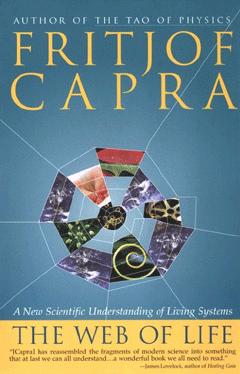Anyone with a systems thinking background and thirst for knowledge will find this complex book to be filled with "nuggets of gold," leading to a deep and powerful understanding of the Web of Life. Unlike other quick reads, this book requires you to take your time with its digestion and really think about the subjects and material provided. Althought some may try, reading it in one sitting is not possible, as many readers will want to research the words and phrases described about the ongoing paradigm shift in science. The book is filled with specific examples and clarifications of how this new scientific understanding is found in Networks, Entropy, Energy, Living Systems, Systems Thinking, Biological, Social and Environmental Theories. Readers who enjoyed Capra's "Tao of Physics" or "The Turning Point" will find this book to be a great stepping stone into new and unique ideas that are thoughtfully presented. The author weaves together numerous theories that seem unrelated such as examples from Thermodynamics to Complexity and Chaos Theory.
Capra has described the system as "an integrated whole whose essential properties arise from the relationships between its parts." He goes on to further explain the need to understand that the "Web of Life" needs to be viewed as "a whole that is more than the sum of its parts." Systems Thinking proposes a context of a larger "whole" interpreted by an interconnected blended synthesis of new scientific, mathematical, and biological discoveries. These discoveries have been exposed in sections of single context of connectedness among established theories, paradigms and ideas associated with bifurcation, cybernetics, tektology, feedback loops, nonlinear mathematics (including chaos theory, hypercycle, and anthropocentric systems and networks. Capra stresses that humans are included in this Self-Organizing network and cannot live separate from the earth's environment. All members of an ecological community are interconnected in a vast and intricate network of relationships, which we call the "Web of Life."
The author also explains the importance of autopoieses, which is the organization of the living referred to as "self-making." The material is further developed by the Chilean neuroscientists Huberto Maturana and Franciso Varela (a former student of Maturana), autopoieses is a general pattern of organization that is common to all living things regardless of the nature and make-up of their components (or composite structure). Maturana explains "living systems are cognitive systems, and living as a process is a process of cognition." To elaborate further, the author sees living systems-organisms, social systems, and ecosystems and completely connected. If an astronaut viewed the earth from space they would recognize a complete system of atmospheric, geological and aquatic systems linked together in a cycle of life. When asked the very complex question of "what is life?"
Capra simply answers that it is "Something made up of pattern and structure."
There are many illustrations and diagrams for models that describe feedback loops, networks of enzymes, dissipative structures, patterns of hexagonal Benard cells, Belousov-Zhabotinskii reactions, Oceanic algae, an evolutionary Daisyworld, an Ueda attractor, fractal geometry and Julia sets. If you have never heard of any of these the book is worth reading just to find out what they look like to create a cognitive roadmap for the reader. The Web of Life opens up many possibilities and cognitive ah-ha's while at the same time captivating first time readers with a constant positive exposure to Systems Theory. |
 Web of Life
Web of Life Web of Life
Web of Life